
Concept explainers
Write Lewis structures for these ions. Show all valence electrons and all formal charges.
- (a) Amide ion, NH2−
- (b) Bicarbonate ion, HCO3−
- (c) Carbonate ion, CO32−
- (d) Nitrate ion, NO3−
- (e) Formate ion, HCOO−
- (f) Acetate ion, CH3COO−
(a)
Interpretation:
Lewis structure of the ions, valence electron and formal charge has to be identified.
Concept introduction:
Lewis structure: The Lewis structure is based on the concept of the octet rule so that the electrons shared in each atom should have 8 electrons in its outer shell. Sometimes the chemical bonding of a molecule cannot be represented using a single Lewis structure. In these cases, the chemical bonding are described by delocalization of electrons and is known as resonance. All the possible resonance structures are imaginary whereas the resonance hybrid is real. These structures will differ only in the arrangement of the electrons not in the relative position of the atomic nuclei.
Valence shell:
The outer most shell of the element is called as valence shell.
Valence electron:
The electrons present in the outer shell are called valence electron.
For example:
Nitrogen element has seven electrons and it has two shells, the second shell is the valence shell and it has five electrons in the valence shell. The five electrons are called as valence electrons.
Formal charge:
The charge on an atom in a molecule is called its formal charge.
Formal charge can be calculated by using following formula,
Explanation of Solution
The given ion is amide ion,
First the skeletal structure for the given molecule is drawn then the total number of valence electrons for all atoms present in the molecule is determined. The next step is to subtract the electrons present in the total number of bonds present in the skeletal structure of the molecule with the total valence electrons such that considering each bond contains two electrons with it. Finally, the electrons which got after subtractions have to be equally distributed such that each atom contains eight electrons in its valence shell.
The valence electron for the hydrogen atom is one, the valence electron for the nitrogen is five, therefore, and the Lewis structure of the ion is given below,
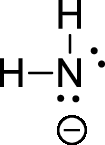
Formal charge can be calculated by using following formula,
(b)
Interpretation:
The Lewis structure of the ions, valence electron and formal charge has to be identified.
Concept introduction:
Lewis structure: The Lewis structure is based on the concept of the octet rule so that the electrons shared in each atom should have 8 electrons in its outer shell. Sometimes the chemical bonding of a molecule cannot be represented using a single Lewis structure. In these cases, the chemical bonding are described by delocalization of electrons and is known as resonance. All the possible resonance structures are imaginary whereas the resonance hybrid is real. These structures will differ only in the arrangement of the electrons not in the relative position of the atomic nuclei.
Valence shell:
The outer most shell of the element is called as valence shell.
Valence electron:
The electrons present in the outer shell are called valence electron.
For example:
Nitrogen element has seven electrons and it has two shells, the second shell is the valence shell and it has five electrons in the valence shell. The five electrons are called as valence electrons.
Formal charge:
The charge on an atom in a molecule is called its formal charge.
Formal charge can be calculated by using following formula,
Explanation of Solution
The given ion is bicarbonate ion,
First the skeletal structure for the given molecule is drawn then the total number of valence electrons for all atoms present in the molecule is determined. The next step is to subtract the electrons present in the total number of bonds present in the skeletal structure of the molecule with the total valence electrons such that considering each bond contains two electrons with it. Finally, the electrons which got after subtractions have to be equally distributed such that each atom contains eight electrons in its valence shell.
The valence electron for the hydrogen atom is one, the valence electron for the carbon is four and valence electron of oxygen is six, therefore, and the Lewis structure of the ion is given below,
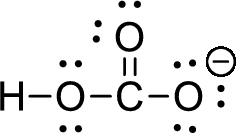
Formal charge can be calculated by using following formula,
(c)
Interpretation:
The Lewis structure of the ions, valence electron and formal charge has to be identified.
Concept introduction:
Lewis structure: The Lewis structure is based on the concept of the octet rule so that the electrons shared in each atom should have 8 electrons in its outer shell. Sometimes the chemical bonding of a molecule cannot be represented using a single Lewis structure. In these cases, the chemical bonding are described by delocalization of electrons and is known as resonance. All the possible resonance structures are imaginary whereas the resonance hybrid is real. These structures will differ only in the arrangement of the electrons not in the relative position of the atomic nuclei.
Valence shell:
The outer most shell of the element is called as valence shell.
Valence electron:
The electrons present in the outer shell are called valence electron.
For example:
Nitrogen element has seven electrons and it has two shells, the second shell is the valence shell and it has five electrons in the valence shell. The five electrons are called as valence electrons.
Formal charge:
The charge on an atom in a molecule is called its formal charge.
Formal charge can be calculated by using following formula,
Explanation of Solution
The given ion is carbonate ion,
First the skeletal structure for the given molecule is drawn then the total number of valence electrons for all atoms present in the molecule is determined. The next step is to subtract the electrons present in the total number of bonds present in the skeletal structure of the molecule with the total valence electrons such that considering each bond contains two electrons with it. Finally, the electrons which got after subtractions have to be equally distributed such that each atom contains eight electrons in its valence shell.
The valence electron the carbon is four and valence electron of oxygen is six, therefore, and the Lewis structure of the ion is given below,
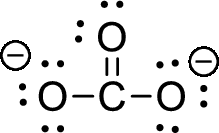
Formal charge can be calculated by using following formula,
(d)
Interpretation:
The Lewis structure of the ions, valence electron and formal charge has to be identified.
Concept introduction:
Lewis structure: The Lewis structure is based on the concept of the octet rule so that the electrons shared in each atom should have 8 electrons in its outer shell. Sometimes the chemical bonding of a molecule cannot be represented using a single Lewis structure. In these cases, the chemical bonding are described by delocalization of electrons and is known as resonance. All the possible resonance structures are imaginary whereas the resonance hybrid is real. These structures will differ only in the arrangement of the electrons not in the relative position of the atomic nuclei.
Valence shell:
The outer most shell of the element is called as valence shell.
Valence electron:
The electrons present in the outer shell are called valence electron.
For example:
Nitrogen element has seven electrons and it has two shells, the second shell is the valence shell and it has five electrons in the valence shell. The five electrons are called as valence electrons.
Formal charge:
The charge on an atom in a molecule is called its formal charge.
Formal charge can be calculated by using following formula,
Explanation of Solution
The given ion is nitrate ion,
First the skeletal structure for the given molecule is drawn then the total number of valence electrons for all atoms present in the molecule is determined. The next step is to subtract the electrons present in the total number of bonds present in the skeletal structure of the molecule with the total valence electrons such that considering each bond contains two electrons with it. Finally, the electrons which got after subtractions have to be equally distributed such that each atom contains eight electrons in its valence shell.
The valence electron for the nitrogen atom is five, the valence electron for the carbon is four and valence electron of oxygen is six, therefore, and the Lewis structure of the ion is given below,
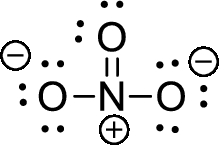
Formal charge for nitrogen atom can be calculated by using following formula,
Formal charge for oxygen can be calculated by using following formula,
(e)
Interpretation:
The Lewis structure of the ions, valence electron and formal charge has to be identified.
Concept introduction:
Lewis structure: The Lewis structure is based on the concept of the octet rule so that the electrons shared in each atom should have 8 electrons in its outer shell. Sometimes the chemical bonding of a molecule cannot be represented using a single Lewis structure. In these cases, the chemical bonding are described by delocalization of electrons and is known as resonance. All the possible resonance structures are imaginary whereas the resonance hybrid is real. These structures will differ only in the arrangement of the electrons not in the relative position of the atomic nuclei.
Valence shell:
The outer most shell of the element is called as valence shell.
Valence electron:
The electrons present in the outer shell are called valence electron.
For example:
Nitrogen element has seven electrons and it has two shells, the second shell is the valence shell and it has five electrons in the valence shell. The five electrons are called as valence electrons.
Formal charge:
The charge on an atom in a molecule is called its formal charge.
Formal charge can be calculated by using following formula,
Explanation of Solution
The given ion is formate ion,
First the skeletal structure for the given molecule is drawn then the total number of valence electrons for all atoms present in the molecule is determined. The next step is to subtract the electrons present in the total number of bonds present in the skeletal structure of the molecule with the total valence electrons such that considering each bond contains two electrons with it. Finally, the electrons which got after subtractions have to be equally distributed such that each atom contains eight electrons in its valence shell.
The valence electron for the hydrogen atom is one, the valence electron for the carbon is four and valence electron of oxygen is six, therefore, and the Lewis structure of the ion is given below,

Formal charge can be calculated by using following formula,
(f)
Interpretation:
The Lewis structure of the ions, valence electron and formal charge has to be identified.
Concept introduction:
Lewis structure: The Lewis structure is based on the concept of the octet rule so that the electrons shared in each atom should have 8 electrons in its outer shell. Sometimes the chemical bonding of a molecule cannot be represented using a single Lewis structure. In these cases, the chemical bonding are described by delocalization of electrons and is known as resonance. All the possible resonance structures are imaginary whereas the resonance hybrid is real. These structures will differ only in the arrangement of the electrons not in the relative position of the atomic nuclei.
Valence shell:
The outer most shell of the element is called as valence shell.
Valence electron:
The electrons present in the outer shell are called valence electron.
For example:
Nitrogen element has seven electrons and it has two shells, the second shell is the valence shell and it has five electrons in the valence shell. The five electrons are called as valence electrons.
Formal charge:
The charge on an atom in a molecule is called its formal charge.
Formal charge can be calculated by using following formula,
Explanation of Solution
The given ion is acetate ion,
First the skeletal structure for the given molecule is drawn then the total number of valence electrons for all atoms present in the molecule is determined. The next step is to subtract the electrons present in the total number of bonds present in the skeletal structure of the molecule with the total valence electrons such that considering each bond contains two electrons with it. Finally, the electrons which got after subtractions have to be equally distributed such that each atom contains eight electrons in its valence shell.
The valence electron for the hydrogen atom is one, the valence electron for the carbon is four and valence electron of oxygen is six, therefore, and the Lewis structure of the ion is given below,
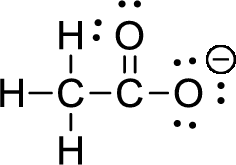
Formal charge can be calculated by using following formula,
Want to see more full solutions like this?
Chapter 1 Solutions
Organic Chemistry
- Formamide, HC(O)NH2, is prepared at high pressures from carbon monoxide and ammonia, and serves as an industrial solvent (the parentheses around the O indicate that it is bonded only to the carbon atom and that the carbon atom is also bonded to the H and the N atoms). Two resonance forms (one with formal charges) can be written for formamide. Write both resonance structures, and predict the bond angles about the carbon and nitrogen atoms for each resonance form. Are they the same? Describe how the experimental determination of the HNH bond angle could be used to indicate which resonance form is more important.arrow_forwardWrite the Lewis structures for CH2N2, including all resonance forms, and show formal charges.arrow_forwardDraw Lewis electron dot diagrams for the following species, indicating formal charges and resonance diagramswhere applicable.(a) H3NBF3 (b) CH3COO- (acetate ion) (c) HCO3- (hydrogen carbonate ion)arrow_forward
 Chemistry: Principles and PracticeChemistryISBN:9780534420123Author:Daniel L. Reger, Scott R. Goode, David W. Ball, Edward MercerPublisher:Cengage Learning
Chemistry: Principles and PracticeChemistryISBN:9780534420123Author:Daniel L. Reger, Scott R. Goode, David W. Ball, Edward MercerPublisher:Cengage Learning General, Organic, and Biological ChemistryChemistryISBN:9781285853918Author:H. Stephen StokerPublisher:Cengage Learning
General, Organic, and Biological ChemistryChemistryISBN:9781285853918Author:H. Stephen StokerPublisher:Cengage Learning Chemistry: The Molecular ScienceChemistryISBN:9781285199047Author:John W. Moore, Conrad L. StanitskiPublisher:Cengage Learning
Chemistry: The Molecular ScienceChemistryISBN:9781285199047Author:John W. Moore, Conrad L. StanitskiPublisher:Cengage Learning Chemistry & Chemical ReactivityChemistryISBN:9781337399074Author:John C. Kotz, Paul M. Treichel, John Townsend, David TreichelPublisher:Cengage Learning
Chemistry & Chemical ReactivityChemistryISBN:9781337399074Author:John C. Kotz, Paul M. Treichel, John Townsend, David TreichelPublisher:Cengage Learning



